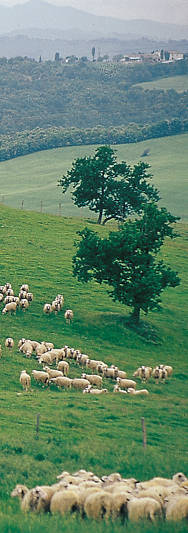 PECORINO
SENESE And MARZOLINO
PECORINO
SENESE And MARZOLINO
Here
is an example of how one can successfully blend many ingredients:
hygiene, quality, taste, aroma, tradition and creativity. As if they
made up a great recipe, these elements are the secret to the cheese
produced by the Caseificio Pinzani in Castelsangimignano which experiments
with new solutions in the combining and blending of Tuscany’s
great products. Here the milk of Apennine breeds of sheep is used
to create great cheeses: some, like the pecorino senese and marzolino,
come from ancient recipes; others, like the tartufello and pepato
senese, have been invented by the expert cheese-makers. All, however,
are made with that fresh milk which gives the cheese a perfume of
pasture grass and all are worked by expert hands of craftsmen who
first break up the whey and then fill and press every single mould.
Typical of Siena and the surrounding towns, pecorino senese is produced
between November and June (although the best ones are made in springtime)
from whole sheep’s milk, milk yeast, rennet and salt. It is left
for over a hundred days to ripen on planks of fir wood and care is
taken to turn the forms at least once a week. Its beautiful consistency
is both compact and buttery, its color is somewhere between white
and light yellow, while its sweet taste hides a light vein of spicy
flavor.
During the Renaissance cacio marzolino was quite commonly found in
Florence and all over the Sienese territories; so much so that it
was considered, together with parmesan, Italy’s best cheese.
Even Lorenzo the Magnificent and Pope Pius II were particularly fond
of this cheese which takes its bizarre name from the best month for
its production (March, in Italian marzo).
Marzolino is unmistakable for its appearance which is like a bread
roll, a shape given it by expert hands (indeed the cheese-maker’s
ability is equivalent to an artist’s!) that turn it on a table.
After thirty days of aging, it is ready to be eaten as can be seen
in its delicate, fragrant consistency and pure white color.
Inventiveness and creativity were used to invent tartufello, the pecorino
senese that is aged from 20 days up to four months and made more precious
by the small scales of Tuber aestivum Vitt: the tenuous perfume of
this summer truffle blends perfectly with this kind of cheese. The
pepato senese is aged for about twenty days and then its rind is covered
with lots of black pepper, giving it taste that is sweet and hot at
the same time.
|
Montalcino | Colle
di Val d'Elsa | Volterra | Casole
d'Elsa | San Gimignano | Poggibonsi
|

